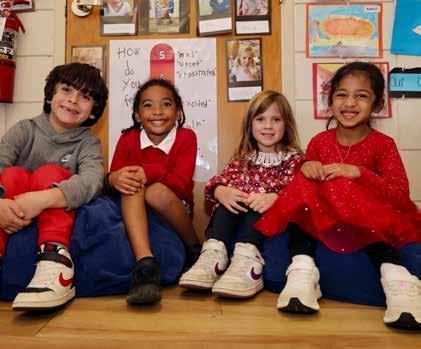
3 minute read
Support Innovative and Inclusive Teaching and Learning
Incorporating DEIB and SEL Strands Throughout the Lower School Curriculum
By Kato Nims, Lower School Director of Studies and Rebecca Patterson, Early Childhood Director
In the Lower School, the Country Day Mission, Affirmation of Community, and Lower School Core Values are the driving forces behind all our work. However, when sitting in a classroom full of spirited five-year-olds, it can be challenging to take those lofty documents and make them resonant without getting a head nod in return. So, to ensure that they are truly lived out every day and integrated into all of our curriculum, we needed to find a way to translate them for our youngest learners on campus.
First, we started with what we had that was working. Our social-emotional concepts and skills have been intentionally taught, practiced, and reinforced throughout every school day. Likewise, Diversity, Equity, Inclusion, and Belonging (DEIB) is a lens through which we view all of our practice in the Lower School. These existing SEL and DEIB learning strands and tools existed separately from each other. We knew there was a connective tissue and wanted to identify the threads, so that SEL and DEIB became woven together and into all learning experiences both inside and outside of the classroom.
So, we got to work! We teamed up with Lower School Counselor J.G. Bailey to identify these connection points between our existing SEL and DEIB skills. As the discussion progressed, we quickly realized that deep understanding and skill development in one area was often dependent upon deep understanding in another area. For example, to display empathy for others and create a community of belonging for everyone (DEIB), students needed to have self-awareness and social awareness that all people have feelings and everyone wants to belong (SEL).
This new framework was developed with the SEL and DEIB strands along with the translated and inter-connected language that our youngest learners can truly understand and use. The SEL strands include self-awareness, self-management, social awareness, relationship skills, and personal decision making. The DEIB strands include empathy and belonging, healthy and complex identities, respect across differences, naming bias, prejudice, and stereotypes, and taking action. As teachers design lessons, they do so with these strands and skills in mind.
Recently, a second-grade class incorporated a DEIB strand while working to develop their relationship skills (SEL). They practiced speaking from the “I perspective” and actively listening as they role played resolving a conflict they might encounter in their everyday life. Empathy and belonging work was woven throughout this activity. Students named potential feelings that their classmates might experience and brainstormed examples of ways to support that classmate to ensure that they felt heard and included. Being in a community, even a small classroom community, allows our students to safely learn and practice skills needed to thrive in their world today.
After two years, we are proud to share that our work is helping teachers deliver a program that is mission-aligned while also building the community we aspire to be. By breaking these strands down with clear definitions and intentions, teachers have been able to integrate these concepts and skills even more intentionally and systematically than ever before.










